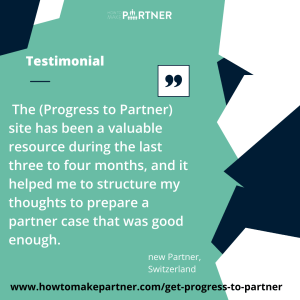The fundamental difficulty involved in the transition to partner is how to still hit your numbers whilst carving out time to build your Business Case and Personal Case for partnership. In fact, for a few years you are going to have two jobs: The day job, and then the extra one to build your own practice demonstrating your readiness for partnership.
\This means you are going to have to manage your time very carefully. Given the fact that your day-to-day responsibilities are changing whilst you are on Partner Track, there are many ‘time traps’ out there. In this article, taken from an extract from my book Poised for Partnership, I share the most common ‘time wasters’ for people on Partner Track:
Networking for networking’s sake
When you are told you need to start to bring in your own work, what is the first thing you do? Go networking. Of course, done well, networking is one of the best ways to grow your profile and generate new business. If you haven’t taken the time to really consider why you are networking, the brand you want to build, and the people you need in your network, you may as well have not gone out networking in the first place. Chapter 8 and 9 of Poised for Partnership will help make sure your networking is fit for purpose.
Poor management of junior staff
 Continual disruptions, poor quality work, too much time spent reworking, are some of the most common complaints I hear about junior staff. Most of these complaints don’t stem from poor quality junior staff. They stem from a lack of good management of your team. Chapter 11 of my book Poised for Partnership will help you polish your people management skills and build a high quality team who you can trust beneath you. You can read Chapter 11 of Poised for Partnership for FREE here
Continual disruptions, poor quality work, too much time spent reworking, are some of the most common complaints I hear about junior staff. Most of these complaints don’t stem from poor quality junior staff. They stem from a lack of good management of your team. Chapter 11 of my book Poised for Partnership will help you polish your people management skills and build a high quality team who you can trust beneath you. You can read Chapter 11 of Poised for Partnership for FREE here
Learning to say “no”
When you are trying to build a high internal and external market value it can be tempting to think that you have to say “yes” to everyone. The reality of the situation is that you will always have partners or team members asking you for things or members of your network wanting to meet you for coffee. Too much “yes” can easily lead to being overwhelmed or not having enough time to do the things that really matter. The best ways to gracefully decline include:
- Helping them find a solution without using you, e.g. “have you tried using…?”
- Explaining your time constraints and finding out if they have any flexibility on timescales or how they want things to be done.
- Using your secretary to manage your diary and act as a gatekeeper for people who want to meet you.
- Offering to help them a little but not the whole hog, e.g. “No, I can’t do that, but I can do this.”
- Ask for time to think about it. You may find that the request goes away or you find a way to fulfil the request in a way that works for you and the other party.
Download your free copy of Chapter 3 of Poised for Partnership here.
Lack of delegation or poor delegation skills
If you are going to expand the amount of time you have to build your practice, you will need to learn to delegate well to more junior staff. Delegation, and how to do it, is explored fully in Poised for Partnership.
. If you don’t delegate, you stop the following happening:
- freeing up your time for more higher value activities, e.g. business development
- generating a good profit margin for the work you are doing
- developing people more junior to you
If you hang on to the work you are given (see point number 3) rather than always looking to delegate everything you can do down, you’ll slowly but surely kill your career. If you can’t be replaced, you also can’t be promoted…
There’s a great course waiting for you in my Progress to Partner Academy called How to Delegate Like a Pro. The course will help you delegate your work to others to free yourself up to focus on more valuable or important things to spend your time on.
Not knowing what you need to do to build your personal and business case
 There is often a huge amount of mystery and conjecture about exactly what it takes to make partner in a firm. This can result in heartache and frustration, leading to procrastination, delays or mistakes being made on the way to making partner. Frequently, many people on Partner Track feel, often wrongly, that they can’t ask the right questions to find out exactly what they need. The best way to avoid this happening to you is to assume that there is no wrong question, and seek out the right information and best source of advice you can.
There is often a huge amount of mystery and conjecture about exactly what it takes to make partner in a firm. This can result in heartache and frustration, leading to procrastination, delays or mistakes being made on the way to making partner. Frequently, many people on Partner Track feel, often wrongly, that they can’t ask the right questions to find out exactly what they need. The best way to avoid this happening to you is to assume that there is no wrong question, and seek out the right information and best source of advice you can.
One of our most sought-after courses in our Progress to Partner online Academy is called “How to Build a Cast-Iron Business Case for Partner”. We think it’s a must-have in your arsenal of tools and guidance to help with your career progression. There is also a section on the Partnership Admissions process with guides and recordings to help you find your way through the system. Find out more about Progress to Partner Academy here.
In summary
What got you to where you are now with your career, may actually start to hold you back on your journey through Partner Track to partner. Take a step forwards to working on your own career development and sign up to my weekly tips here and you’ll find out what you need to be working on in your career development (and how to make the time for your career development) to progress your career in your firm.








